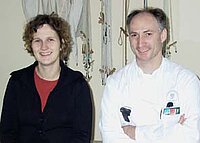Clinical trial of medical condition in combination with HSP including the physiotherapeutical treatment

Applicant: Bernhard Heimbach, Assistent doctor of "Neurologische Klinik und Poliklinik Hamburg-Eppendorf Martinistrasse 52 20246 Hamburg" together with: Dipl. Psych. Stefanie Kraft Zentrum für Psychosoziale Medizin Institut und Poliklinik für Medizinische Psychologie am UKE Eppendorf
Ambulant Physiotherapy of Hereditary Spastic Paraplegia (HSP)
Heimbach B, Kraft S, Winkler G, Sach M, Raji A, Koch U, Weiller C
Hereditary Spastic Paraplegia (HSP) is a neurodegenerative disorder in which progressive spastic paraparesis represents the predominant clinical symptom. As there is no definitive therapy symptomatic treatment becomes significant. Supportive treatment consists of antispastic medication and the local application of botulinum toxin A and includes especially physiotherapy and supportive devices, both adapted to the functional deficit.
As presented in the case report by Richardson and Thompson (1) physiotherapy adapted to the functional deficit not only causes a reduction of spasticity, but even more improves mobility and activities of daily living. In addition physiotherapy influences pain, quality of life, and individual perception of the disease. It has been shown that in the treatment of HSP physiotherapy can not only reduce spasticity, but also diminishes depletion, numbers of falls and backaches significantly.
However, it is unknown which concepts and methods of physiotherapy result in best responses in the preservation of motor functions and in maintaining the patient’s ability to stay in the work force to the criteria for rehabilitation defined by the WHO (2). It is also unknown to which extent quality of life and coping with the disease can be influenced by PT.
In the first part of this study a group of about 80 patients and their therapists will be asked about dosage and concepts of the individual physiotherapy. The effectiveness of the treatment will then be rated by the patients. The following issues will be investigated:
Self-care (Barthel Index);
- Assessment of patient’s requests about treatments, acceptance and patients´ response to physiotherapie concerning the WHO-criteria: Impairment, disability and handicap (2);
- Quality-of-life (SF 36);
- Anxiety and depression (HADS);
- Evaluation of additional therapies and supportive devices.
Data is collected using questionnaires and is analysed in a descriptive cross-sectional study.
On the basis of this data we will discuss the results with patients, therapists, physicians, and specialists for rehabilitation and HSP to develop an appropriate treatment plan considering the stage of disease and other supportive treatment like antispastic agents. A successive prospective longitudinal group study will be performed to evaluate the treatment plan for its effectiveness.
Literature: 1. Richardson D, Thompson AJ, Management of spasticity in hereditary spastic paraplegia,
1999, Physiotherapy Research International, 4 (1)
2. Hummelsheim, Die Rehabilitation zentraler Lähmungen – eine Standort-bestimmung, 1996, Aktuelle Neurologie 23: 7 – 14




